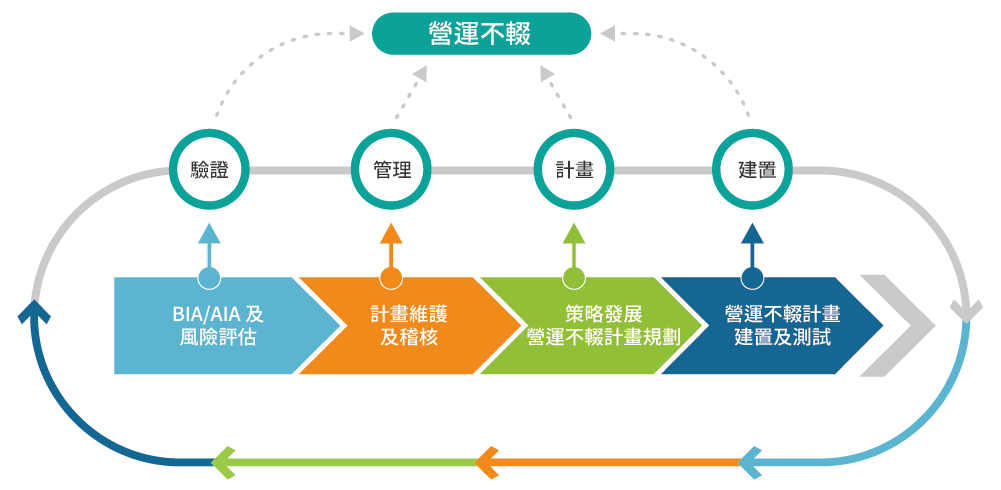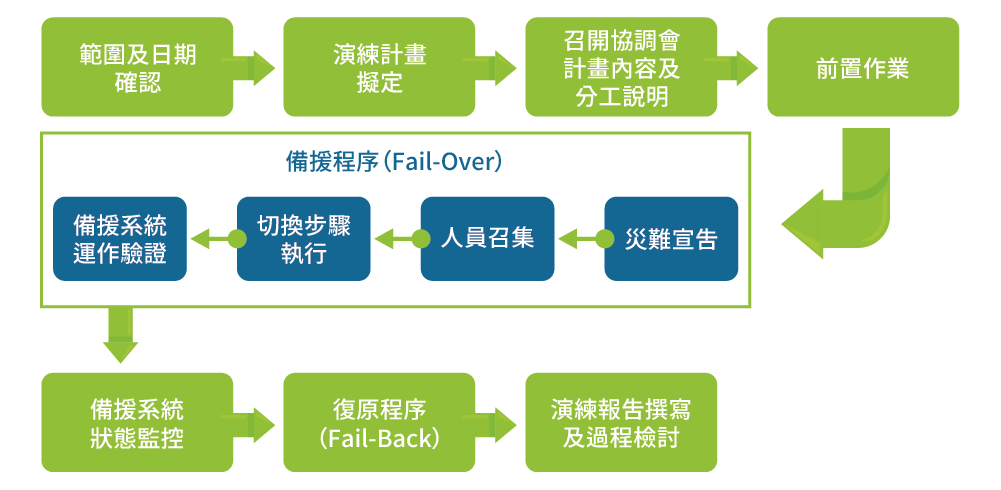Acer e-Enabling Data Center, Inc. (acer eDC) cooperated with SunGard of the United States on remote backup technology in 2002. It has implemented remote backup theory into practical applications in the information field of various industries, and has won the trust of enterprises. Combined with the development of cloud services in recent years, using cloud services as an off-site backup option has become a trend. It is also a demonstration of acer eDC's customer backup capabilities. Through daily and reliable recovery drills, the system can be used in disasters. When the time comes, the information system can be quickly activated to provide services.
Service Efficiency
- Business Continuity Management(BCM)
is to ensure that when a company encounters an accident such as a natural disaster or a man-made disaster, the company's important operational processes are not affected by major information system failures or disasters and can still continue to operate. Through a combination of preventive and recovery control measures, the company's impact is minimized and the impact of risks is reduced to an acceptable level.
- Business Continuity Planning(BCP)
is to protect the company's operations from disasters and accidents, and to prepare contingency plans in advance to prevent and reduce the impact of emergencies on the enterprise, including unpredictable natural disasters. Prevention of man-made disasters, such as earthquakes, typhoons, fires, power outages, etc. - Disaster Response Planning(DRP)
When an accident occurs to a company, disaster recovery capabilities are an important part of allowing the company to continue operating. Disaster recovery plans include resource relocation, backup measures, emergency response, and operational recovery to shorten the impact of disaster on business interruption and speed up recovery to ensure the sustainable operation of the organization.
A Life Cycle of Uninterrupted
In order to achieve uninterrupted operations, it is necessary to analyze various risks, formulate countermeasures against these risks, and develop a continuous operation management mechanism so that rapid recovery can occur in the event of a major disaster. This includes operations continuation plans and disaster recovery plans that must also meet organizational requirements. Tests and drills are conducted on personnel management, access control management, and physical environment security management. Finally, audits and reviews are conducted, and relevant information is continuously updated. plan.

Glossary
Business Impact Analysis(BIA)
Aims to identify the impact of unsustainable operations (i.e. losses or interruptions) and restore operations to the lowest operating level; in addition to understanding the key operating processes in the organization and what is needed to support these processes requirements and evaluate the time and related resources required for recovery.
RPO(Recovery Point Objectives)
the time between when a disaster occurs and the completion of the latest backup. The data during this period will not be backed up and the time point at which the data can be restored.
RTO(Recovery Time Objectives)
starts from the time when a disaster is declared after the system shuts down, until the off-site backup system is started and completely takes over the operation of the main computer room, until the main computer room is operating normally and can withstand the maximum time point. Can tolerate maximum downtime.

Off-Site Backup Process
Off-site backup is usually part of the disaster recovery plan. The main purpose is to back up the company's important data to different locations. When any disaster or force majeure occurs, the data and systems can be quickly restored to the off-site location through the off-site backup. Start the service to minimize the loss of system downtime. To plan remote backup, the main process is as follows:

Risk Analysis
- Target
- Identify mission-critical operational processes: Determine backup targets.
- Determine the maximum acceptable downtime for each operational process: determine the RTO time.
- Determine the minimum acceptable response resource requirements for each operational process: Set RPO time.
- Method
- Operational shock analysis.
- Apply system impact analysis.
Strategic Planning
- Determine the level of the backup center: such as Cold Site, Warm Site, Hot Site...
- Determine the method of data protection (selection of backup technology): tape backup, data synchronous copying, etc.
- Determine the personnel organization and division of labor: The organization that implements the recovery plan will form different types of teams based on the degree of system impact, such as: management team, system recovery team, data recovery team, network recovery team, application system recovery team, media relations team , Regulatory Affairs Group, etc.
Information Operation Planning
- Construction Planning
- Goal confirmation: Set goals based on RTO & RPO.
- The target of the backup scope.
- Architecture Planning
- Data backup method: synchronous or asynchronous solution selection.
- Host architecture and configuration: one-to-one or many-to-one, server specification level, cloud service.
- Network architecture and switching: data transmission bandwidth assessment, main center and backup center, external points and backup center.
- DNS architecture and switching: internal and Internet access.
Information Operation Construction
- System installation and setup.
- Establishment of backup mechanism.
- Establishment of monitoring mechanism.
- Software and hardware functional verification.
- Drill and verify the backup process.
- Document output: such as Fail-Over and Fail-Back standard operating procedures, test reports, off-site backup drill plans, off-site backup drill reports, etc.
Drills and Tests

Audit and Review
- 目Purpose: To enable continuous updating of files, ensure the availability of backup application systems, and train recovery personnel.
- Audit and Review: Review the backup drill report.



